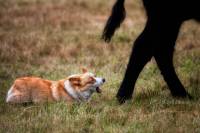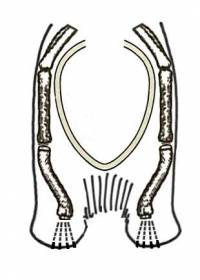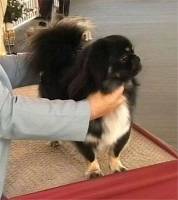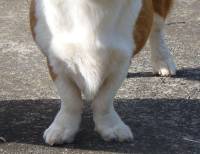Other Short Legged Breeds
 Welsh Corgi (Pembroke) Heeling
Welsh Corgi (Pembroke) Heeling
This section explains a dog's short legged construction. This includes how cattle dogs with shortened legs were able to evade the retaliatory kick when the dog moved cows by nipping at their heels. The second section explains excessively bowed legs and dwarfism, deformities which may develop should the shortening of legs become exaggerated.
Front Legs and Ribcage
The front assembly is made up of the shoulder blade, forearm or humerus, and the front legs themselves. To begin, let's look at the length and placement of these components independently.
 Short Legged Dog (Front)
Short Legged Dog (Front)
The length and placement of the shoulder blade or scapula, and upper arm or humerus, determines what we call 'lay of shoulder'. This should not be affected by the components of the leg beneath it. Where the upper arm, or humerus meets the front leg you have what is called in dog jargon, the elbow. When you consider whether the elbow is placed alongside the ribcage or beneath it, you have an important factor in determining the shape of the front legs.
 Short Legged Dog (Side)
Short Legged Dog (Side)
The front legs are physically attached to the chest wall by sinews and muscles. As the front legs mould themselves around the ribcage, they are affected by its shape and depth. So when the chest extends too far below the elbows, the shortened front legs have to bend around it, or they would be placed too wide apart to enable the dog to function (or the terrier to dig) productively.
It is important also to understand that although the words "crooked front", achondroplasia or dwarfism[2] are sometimes used when describing this type of front, because these terms can indicate a genetic abnormality, modern breeders tend to shy away from these particular terminologies.
Bowed Front Legs, Shortened Legs and Dwarfism
 Tibetan Spaniel
Tibetan Spaniel
Sometimes also called a crooked front, as explained above a slight bow in shortened front legs allows them to mould neatly around the chest if it extends below the elbow as illustrated in the Tibetan Spaniel on the left. However, it is important that the pastern is straight and NOT turned outwards ("east-west") like the dog on the right which can be a sign of Dwarfism or Achondroplasia.
 Dwarfism or Achondroplasia
Dwarfism or Achondroplasia
Dwarfism or Achondroplasia is a genetic abnormality which displays itself during the growth stage when a puppy's legs do not grow to normal length. This can cause excessive bow in the front legs, especially if they are moulded around a chest that extends below the elbows. This abnormal trait can occur in some breeds like Dachshunds, Cardigan Welsh Corgis and some of the short legged Terriers.
As this condition is genetically acquired, it should be remembered that this abnormality can cause arthritis and other problems for the dog as it ages. As such it is important for judges and breeders alike to select for short legs with only a slight bow and straight pasterns. In other words exaggeration of the bow in the front legs with the corresponding outward turn in the pastern as shown here should be actively discouraged.
References and Further Reading
[2] Jane Harvey, "Dwarfism in Terriers" in Dog News Australia (Australian Canine Press Pty Ltd, Austral NSW) ISSN 1834-1837 January 2008 page 6
[3] Jane Harvey, "Incorrect Front Construction" in Lets Talk Terriers (Tracy Murphy, Dean Park NSW) Vol 2 No 2 2006 Pages 2-4
[4] Jane Harvey, DVD "Terriers Then & Now" (Rangeaire Vision 2002, 2004) ISBN 978-0-9804296-4-0